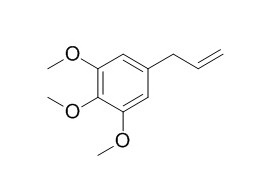Elemicin
Elemicin has anticancer, and antifungal activities, it exhibits anticholinergic-like effects in humans.
Inquire / Order:
manager@chemfaces.com
Technical Inquiries:
service@chemfaces.com
Tel:
+86-27-84237783
Fax:
+86-27-84254680
Address:
1 Building, No. 83, CheCheng Rd., Wuhan Economic and Technological Development Zone, Wuhan, Hubei 430056, PRC
Providing storage is as stated on the product vial and the vial is kept tightly sealed, the product can be stored for up to
24 months(2-8C).
Wherever possible, you should prepare and use solutions on the same day. However, if you need to make up stock solutions in advance, we recommend that you store the solution as aliquots in tightly sealed vials at -20C. Generally, these will be useable for up to two weeks. Before use, and prior to opening the vial we recommend that you allow your product to equilibrate to room temperature for at least 1 hour.
Need more advice on solubility, usage and handling? Please email to: service@chemfaces.com
The packaging of the product may have turned upside down during transportation, resulting in the natural compounds adhering to the neck or cap of the vial. take the vial out of its packaging and gently shake to let the compounds fall to the bottom of the vial. for liquid products, centrifuge at 200-500 RPM to gather the liquid at the bottom of the vial. try to avoid loss or contamination during handling.
Oncotarget.2016, 8(51):88386-88400
Biol Pharm Bull.2018, 41(1):65-72
Acta Biochim Pol.2015, 62(2):253-8
Korean Journal of Pharmacognosy2014, 113-120
Food Funct.2022, D1FO03838A.
Front Pharmacol.2021, 12:764297.
ACS Synth Biol.2020, 9(9):2282-2290.
Environ Toxicol.2020, doi: 10.1002
Plants (Basel).2021, 10(6):1119.
Bioorg Med Chem.2018, 26(14):4201-4208
Related and Featured Products
Chem Res Toxicol. 2012 Nov 19;25(11):2352-67.
Physiologically based kinetic models for the alkenylbenzene elemicin in rat and human and possible implications for risk assessment.[Pubmed:
22992039]
The present study describes physiologically based kinetic (PBK) models for the alkenylbenzene Elemicin (3,4,5-trimethoxyallylbenzene) in rat and human, based on the PBK models previously developed for the structurally related alkenylbenzenes estragole, methyleugenol, and safrole.
METHODS AND RESULTS:
Using the newly developed models, the level of metabolic activation of Elemicin in rat and human was predicted to obtain insight in species differences in the bioactivation of Elemicin and read across to the other methoxy allylbenzenes, estragole and methyleugenol. Results reveal that the differences between rat and human in the formation of the proximate carcinogenic metabolite 1'-hydroxyElemicin and the ultimate carcinogenic metabolite 1'-sulfoxyElemicin are limited (<3.8-fold). In addition, a comparison was made between the relative importance of bioactivation for Elemicin and that of estragole and methyleugenol. Model predictions indicate that compound differences in the formation of the 1'-sulfoxymetabolites are limited (<11-fold) in rat and human liver. The insights thus obtained were used to perform a risk assessment for Elemicin using the margin of exposure (MOE) approach and read across to the other methoxy allylbenzene derivatives for which in vivo animal tumor data are available. This reveals that Elemicin poses a lower priority for risk management as compared to its structurally related analogues estragole and methyleugenol.
CONCLUSIONS:
Altogether, the results obtained indicate that PBK modeling provides an important insight in the occurrence of species differences in the metabolic activation of Elemicin. Moreover, they provide an example of how PBK modeling can facilitate a read across in risk assessment from compounds for which in vivo toxicity studies are available to a compound for which only limited toxicity data have been described, thus contributing to the development of alternatives for animal testing.
Chem Res Toxicol . 2019 Oct 21;32(10):1965-1976.
Metabolic Activation of Elemicin Leads to the Inhibition of Stearoyl-CoA Desaturase 1[Pubmed:
31468958]
Abstract
Elemicin is a constituent of natural aromatic phenylpropanoids present in many herbs and spices. However, its potential to cause toxicity remains unclear. To examine the potential toxicity and associated mechanism, Elemicin was administered to mice for 3 weeks and serum metabolites were examined. Enlarged livers were observed in Elemicin-treated mice, which were accompanied by lower ratios of unsaturated- and saturated-lysophosphatidylcholines in plasma, and inhibition of stearoyl-CoA desaturase 1 (Scd1) mRNA expression in liver. Administration of the unsaturated fatty acid oleic acid reduced the toxicity of 1'-hydroxylElemicin, the primary oxidative metabolite of Elemicin, while treatment with the SCD1 inhibitor A939572 potentiated its toxicity. Furthermore, the in vitro use of recombinant human CYPs and chemical inhibition of CYPs in human liver microsomes revealed that CYP1A1 and CYP1A2 were the primary CYPs responsible for Elemicin bioactivation. Notably, the CYP1A2 inhibitor α-naphthoflavone could attenuate the susceptibility of mice to Elemicin-induced hepatomegaly. This study revealed that metabolic activation of Elemicin leads to SCD1 inhibition in liver, suggesting that upregulation of SCD1 may serve as potential intervention strategy for Elemicin-induced toxicity.



